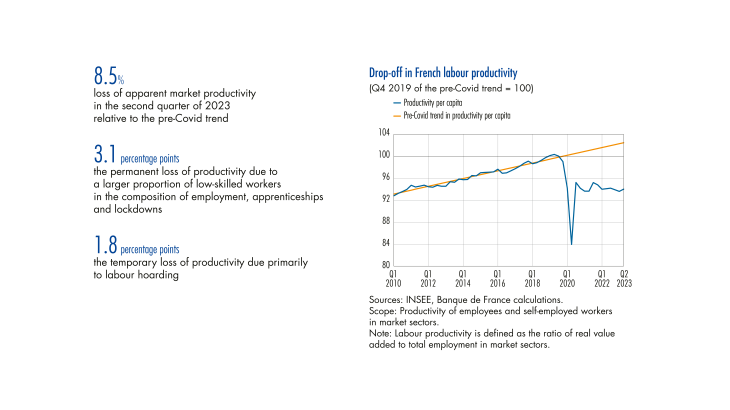Apparent labour productivity has fallen in France since 2019. Devulder et al. (2024) estimate that productivity observed in the second quarter of 2023 was 8.5% below the level that would have been reached had productivity remained on its 2010-2019 trend. They break down the effects of various temporary and permanent factors contributing to the productivity disconnect in market sectors (see below). Ultimately, a significant share of the fall reflects not a loss of productive potential, but rather increased employment intensity of economic activity through a switchover effect between labour productivity and the quantity of jobs.
This article looks at the manufacturing sector, which has special importance due to the potential for productivity gains (since productivity in manufacturing is higher and more dynamic than in the services sector) and job creation, at a time of structurally high unemployment. It seeks to identify and quantify the relative importance of various factors that might affect the determinants of labour productivity in the manufacturing sector, such as jobs, hours worked and hourly productivity, and to provide insights into potential drivers that might enable companies to boost their productivity, as well as possible obstacles in their way. To do this, it relies on the Banque de France’s survey of production conditions at manufacturing companies, which is conducted every year between September and December. The thematic section of the 2023 survey addressed evolutions in employment and labour productivity. The survey data provide a sectorlevel and microeconomic perspective that supplements the macroeconomic analysis derived from national accounts data and discussed in another Banque de France article on the topic (Devulder et al., 2024). This is useful because labour productivity trends observed at the macroeconomic level may conceal different developments across sectors of activity or even between companies operating within the same sector depending on their size.
1 The downturn in manufacturing labour productivity in 2023
In 2023, labour productivity was still below its pre-Covid level
Apparent labour productivity indicators have followed an uneven path in France since the outbreak of the Covid health crisis. Based on national accounts data, while employment has been vigorous, economic activity measured by real value added has see-sawed since 2019. By the third quarter of 2023, it was just 1.8% above its 2019 level. This caused productivity to disconnect from its pre-crisis trajectory, as employment growth outpaced the increase in value added. …
